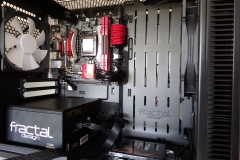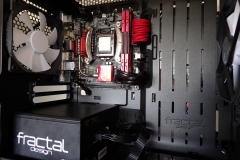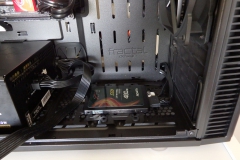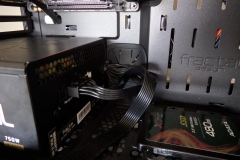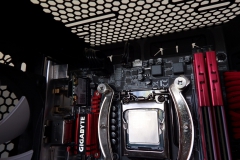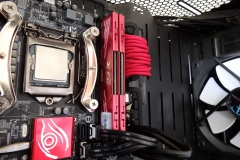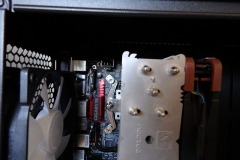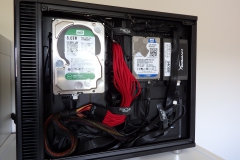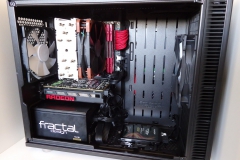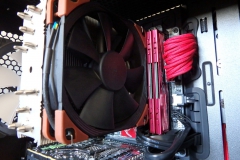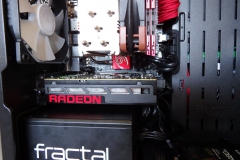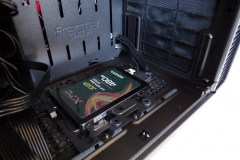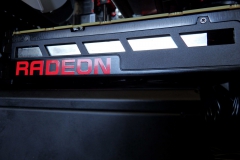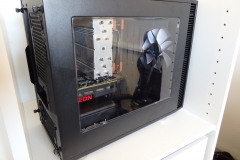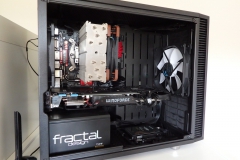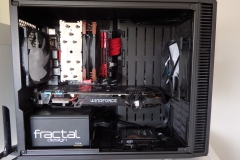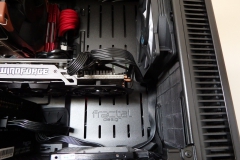We make every effort to undertake a practical build inside any case that we review – it’s our belief that we don’t really fully appreciate the design and build quality unless we have actually built a rig in it and used it for a period of time. In this review, we used the Gigabyte Z97N Gaming 5 from our Fragabyte build.
We undertook the majority of our testing with the AMD R9 Nano ITX graphics card but in the final stage of the review, we installed the larger Gigabyte GTX 970 Gaming G1 card that doesn’t have an external vent on the card itself. This made very little difference to the thermal performance of the Define Nano S.
The configuration involved a 120mm tower cooler (the largest we could fit) and we also used as many drive mounting points as were available with the ADATA XPG SX930 480GB SSD, the Kingston HyperX Fury 240GB SSD, Western Digital 1TB Blue SSHD and the full sized 6TB Western Digital Green drive as an archive storage space. After loading these in and cabling them all up, the case still looked sparse through the window.
The full specifications are listed below:
- i5-4670K @4.4GHz
- Gigabyte Z97N Gaming 5
- ADATA XPG V1 DDR3
- Noctua NH-U12S with iPPC 2000 120mm fan
- 24 Pin cable extension (for neatness)
- AMD R9 Nano
- ADATA SX930 480GB SSD
- Kingston HyperX 240GB SSD
- 1TB 2.5″ WD Blue SSHD
- 6TB WD Green HDD
- Fractal Design Integra-M 650W PSU
- Logitech G310 Atlas Dawn Keyboard
- Razer DeathAdder Chroma Mouse
- Kingston Cloud Headset
- BenQ XL2730Z 27″ 1440p 144Hz Gaming monitor
Initially there was a concern about the PSU and the NANO FAN in terms of obstruction but it didn’t cause us any issues in the end.
The build process was very easy and looked great with nice obstruction-free airflow from the front intake to both the CPU and GPU coolers. The cables were also easily concealable – even with a 24Pin cable extension in use.
At idle, the case was as close to silent as you can get. At full throttle when gaming whilst overclocked, the case wasn’t silent but it had a lower acoustic profile and slightly better temperatures than the Core 500 case that we tested with the same components.
The front fan is 140mm and does a great job with minimal noise. Fitted with a rear 120mm fan there is also a slider adjustment feature to allow the builder to offset the fan which is handy when water cooling and working around a roof mounted radiator.

The rear IO cut-out was spot on and the CPU back plate cut-out is both generous and functional. It might sound obvious but it’s worth highlighting that we have seen cases (from another manufacturer) where the rear I/O shield cut-out is either too tight or too loose and the CPU cut-out isn’t always a practical size.
Another thing that we really liked here were the side panel thumbscrews that don’t come all the way out – just like we saw on the Define R5 case. This is brilliant because it makes it virtually impossible to lose them.

You want a 24-pin cable extension kit if using this case and Fractal Design might want to consider either making these or including a set as an option to help keep things neat and eliminate the dreaded 24-pin cable-kink of most standard PSU power cables.
Testing
AMD R9 Nano GPU reached 83C after more than 2 hours of constant gaming load. The fan noise was audible outside the case but wasn’t considered loud. We also overclocked the CPU to 4.4GHz @1.29v using a Noctua NH-U12S with a Noctua iPPC 2000 fan fitted. The CPU temperatures we saw topped out in the low 70C range. For an overclocked gaming setup in a small case with one intake and one exhaust, this was a good result as far as we were concerned.
We used the practical build a few weeks at the end with a GTX 970 G1 Gaming card installed – (Sadly, the R9 Nano had to go back to AMD). Swapping out the tiny but beastly R9 Nano for the much larger GTX 970 Windforce 3x graphics card didn’t impact on temperatures in any notable or consistent way so the airflow of the Define Nano S chassis appears to be ample.
Whilst this case is begging to house a water cooled build, we like it for air cooling to keep things simple and neat.
The rear 120mm fan is the loudest part of the build which is a credit to Fractal Design because it really doesn’t make that much noise.
This case has lived in a number of locations in and out of the lab as we moved it around. The size and shape makes it easy to place and we found many a home for the test build over the 6 weeks that we tested it. One location was tucked away in a corner on top of a 2 drawer filing cabinet where there was still room for clutter to sit in front of it. This goes to show how the Nano S could be great in a bedroom, dorm, study or living room.
We also sat the test build on a carpet floor between 2 pieces of furniture to try and get some dust into the filters. The results were not exactly conclusive due to the timeframe but there was a little dust, fluff etc. in the filters and none visible inside the case so based on 2 weeks of ‘dust’ testing, the filters look to be effective. They are easy to remove but you need to tilt the case a little.

